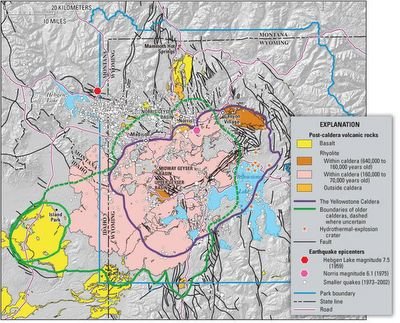
Steamboat Geyser in steam phase on May 2, 2000 at 10:00 AM (5:00 AM eruption); Norris Geyser Basin; NPS photo (Tom Cawley)

Geysers are rare. According to Geyser World there are approximately 1000 active geysers in the world, with about 500 of them being in Yellowstone National Park. For a listing of active, dormant and exinct geyser one should visit Johnston's Archive Geyser Resources.
In order for a geyser to form, three conditions must be met:
1. an abundant supply of water
2. a heat source
3. special plumbing
The problem is the special plumbing. Most geysers are found in the volcanic rock rhyolite, a high silica rock. Fields of rhyolite are rare hence geysers are rare. The site, “Geyser World”, goes on to give a readable explanation of what happens before and during an eruption. Geysers and the Earth's Plumbing System also explains what factors are needed for a geyser to exist and how a geyser erupts. Some of the links on this page do not work but it is well worth a visit. A cross-sectional diagram illustrates the three conditions that must be met to get geyser activity - heat, water and a reservoir. There are pictures of six basic type of plumbing systems that a geyser might have. The discussion after that gets more scientific in nature.
I have seen WyoJones' Geyser site referred to as the best geyser site on the web. There is a lot of useful information, most notably a section on the continuing survival of geysers. Geysers are temporary geological features. Many factors (either natural or man made) can alter or destroy them. Here, one can find out what dangers geysers have faced and what the greatest threat to their existence is right now. There is a list of geyser that have been damaged or destroyed. It is really a shame.
Is it possible to visit a geyser online? Sure! And where else would one go but to Yellowstone National Park. This is a great site. The tour starts with a visit to the various basins. A geyser basin is just an area that contains a group of geysers. After having finished strolling around the basins, it continues on stopping at each geyser individually. There are movies showing each geyser erupting. Or, one can visit National Park Service's Yellowstone National Park and take in the online nature tours.

Old Faithful Geyser; Upper Geyser Basin; NPS Photo (Jim Peaco)

The underlying geological feature of Yellowstone National Park is a caldera. For a definition of the word caldera visit USGS’s Photo Glossary of Volcanic Terms . For more information on calderas, not only in Yellowstone Park but around the world, one can visit USGS site Calderas and Caldera Formation.

Yellowstone Caldera map

A great site for kids is Making Better Sense of the Planet Earth and Beyond. Here, one can learn how to make his/her own geyser.
Lastly, the site Inside Old Faithful gives an account of what scientists saw when they lowered a camera down inside. Unfortunately, one thing they did discover was that the hot water was depositing silica on the walls of the vent. Old Faithful will eventually become clogged and will die. Let's hope that fate is a long ways in the future.